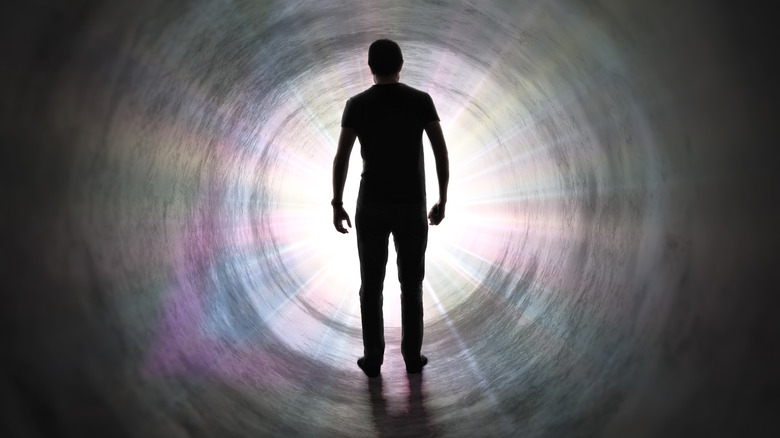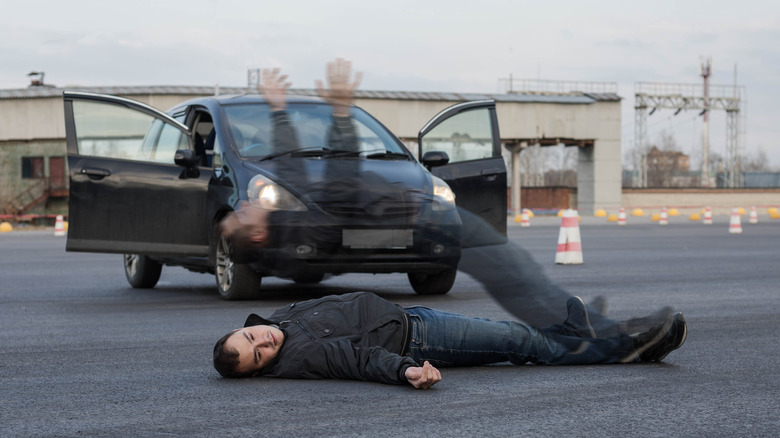The Mystery Of The 'Light At The End Of The Tunnel' Before Death May Never Be Solved
The legal definition of death varies by circumstance, and the same goes for the individual's definition of death. With so many medical advancements and differing spiritual beliefs, when a person is able to be declared dead can change on a case-by-case basis. According to NPR, some states like New York and New Jersey are able to consider a family's religious and moral beliefs before legally pronouncing a patient dead.
The shroud of death eventually comes for everyone. However, for some, it doesn't necessarily take hold entirely the first time around. Those who have come close to death oftentimes recall profound experiences involving feelings of peace, bliss, and apathy for their life on Earth. One other detail recalled by many who face death but live to tell the tale is a bright, sometimes described as ethereal light. Or "the light at the end of the tunnel," so it goes. The bright light that is said to be seen before a person dies is a popular yet unsolved theory of what happens when a soul leaves its body forever. Television shows and movies often even poke fun at this theory by telling characters not to go into the light. So it's surprising that such a well-acknowledged theory about death is still not understood.
Near-death experiences are studied extensively
"Near-death experience" is a term coined by author Raymond Moody in his book "Life after Life" (per Scientific American). Though, the occurrence of near-death experiences has always been prevalent. While little is known about what happens in the limbo between life and death, the knowledge of the subject is highly sought after. An entire department at the University of Virginia School of Medicine, the Division of Perceptual Studies, is dedicated to learning more about cases like near-death experiences.
A study published in Frontiers and discussed in ScienceDaily was conducted on the varying accounts of near-death experiences at the University Hospital of Liège, Belgium. Research indicated that out of the 154 participants, 69 percent of them recalled seeing a bright light, 64 percent of them interacted with spirits or people, and 80 percent of participants experienced feelings of peace.
Even with similar accounts of what happened, each individual experienced them differently and in different orders. An author of the study, Charlotte Martial, said of the findings in a statement published by HuffPost, "Further research is necessary to explore these differences and the precise extent of which content of those experiences reflects their expectations and cultural backgrounds, as well as the neurophysiological mechanisms underlying near-death experiences." With so many varying accounts of what happens after death — or rather what happens somewhere between life and death — it's difficult to say what exactly people are seeing when they describe this bright light.
More research is needed to better understand the phenomenon
For many, their near-death experience was a profound spiritual moment, regardless of seeing the bright light. The presence of feelings of peace and bliss, or lack thereof, is enough for some to confirm or deny the existence of heaven or hell. Though, records show that near-death experiences are no more likely to affect a religious person than a non-religious person, according to Scientific American. The extreme experiences that accompany many of these idiosyncratic recollections are comparable to that of certain hallucinogenics such as DMT and psychedelic mushrooms, which both contain psilocybin, an ingredient that activates serotonin.
One record published in Scientific American from 1900 is from a surgeon, Sir Alexander Ogston, where he states, "I lay, as it seemed, in a constant stupor which excluded the existence of any hopes or fears. Mind and body seemed to be dual and, to some extent, separate. I was conscious of the body as an inert tumbled mass near a door; it belonged to me, but it was not I." Ogston was ill with typhoid fever at the time of his near-death experience.
The remarkable accounts of what happens to those who beat death, even for a little while, are a fascinating reminder that there is much to learn about life, death, and human consciousness. While we may never know what the bright light at the end of the tunnel is while we're alive, many of us might just find out eventually.


